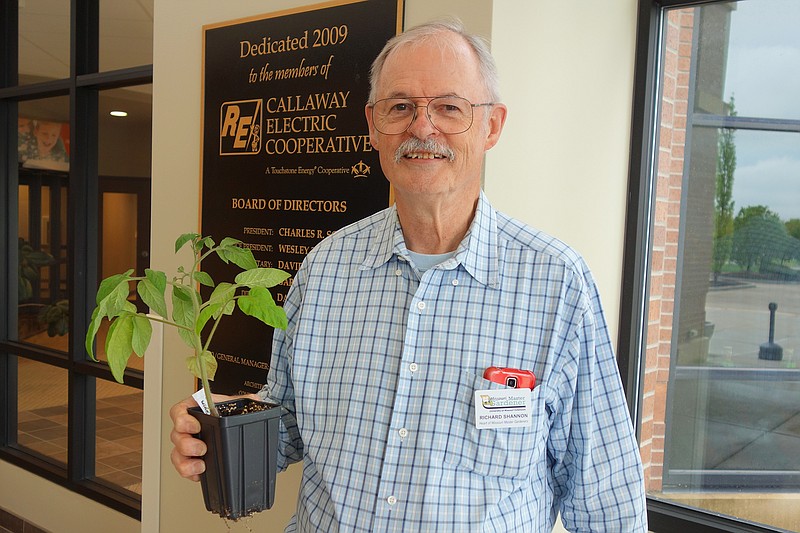His garden's overflowing with tomatoes, he's got a box stuffed with their seeds - and his wife doesn't even like them.
But Master Gardener Richard Shannon can't help it. He caught the gardening bug from his grandfather more than 40 years ago, and tomatoes are among his favorites. During Tuesday's Women in Agriculture conference, he taught attendees about how to choose, grow and save the seeds of tomatoes.
Each year he pores over the colorful seed catalogs to see what's new.
"If you're like me, about a week after New Year's, you start getting seed catalogs," Shannon said. "They get us when we're most vulnerable."
Not all tomatoes are created equal, and people have differing opinions about what makes a great one. Some prioritize flavor above all. Others want disease resistance while others may want attractive fruit and rapid production.
"Some people like to take more risks than others, but if you need to take the tomatoes to a farmers market, you'll need something more dependable," Shannon said.
In other words: Get your priorities straight before shopping for tomatoes. Then, turn to the descriptions in the seed catalogs and websites you browse. Some factors a beginning gardener might not know to look at include days to maturity, indeterminate vs. determinate and hybrid vs. open-pollinated.
Days to maturity describes how long it takes for a tomato to grow from seed to fruit. In Missouri, an efficient farmer might be able to grow two full crops of 65-day tomatoes, Shannon said.
Indeterminate and determinate describe how the plant produces fruits. A determinate plant puts out all of its tomatoes at once - these tend to be commercial varieties. An indeterminate one might put out a few fruits a week for a longer period.
Hybrid and open-pollinated refer to how the tomato variety was developed. This matters to a seed-saver because an open-pollinated tomato's seeds should grow "true to type," meaning they'll have the characteristics of the parent plant. A hybrid tomato's seeds won't, Shannon explained.
Shannon also encourages comparing reviews for different varieties; vegvariety.cce.cornell.edu is a great place to start, he said.
He's also an advocate for starting your own seeds. This Fulton Sun article will teach you how: bit.ly/2JgZX0S.
"Don't buy a stressed-out, neglected plant," Shannon said.
Make sure your soil is ready for tomatoes by getting it tested and adding compost as necessary, Shannon said. Poor soil grows poor tomato plants.
"Ask yourself, do I want tomatoes this summer, or do I want to bang my head against the wall all summer long?" he told the audience.
Put down mulch around the plants to help retain water and prevent dirt from splashing up onto your plant (that can transmit diseases to the plant's leaves, he said). A tomato wants full sunlight and 1-2 inches of water per week.
"If you plant your tomatoes in your sunniest spot, they'll be happy and you'll be happy," Shannon said.
Be careful not to overwater your plants - that makes for bland tomatoes, he added.
For a natural soil dampness indicator, plant some impatiens flowers among your tomatoes - they'll droop when it's time for more water. Otherwise, stick a finger into the soil and give it a gentle soak when it's dry to your second knuckle.
A sudden rain or too much watering can cause your tomato fruits to crack, so Shannon recommends harvesting ripe tomatoes when there's rain in the forecast, rather than after.
Saving seeds from your favorite variety can save you money the next year, and it's easy to do, Shannon said.
The simplest method involves simply spreading the seed-filled jellylike mixture from your tomatoes onto paper towels and allowing it to dry.
To encourage a high germination rate the next year, he suggests putting that seed goo into a jar with some water, covering it and waiting a while. Good seeds will sink to the bottom, and the goo and infertile seeds will rise to the top. Drain it off, give the seeds a rinse and allow them to fully dry before bagging and labeling them.
Stored in a dry, cool place, the seeds can last for years.
If the bees managed to cross-pollinate your tomato flowers, you may get some surprising crosses the next year - but that's just part of the fun.
"Seeds are the way a parent plant sends a letter to the future," Shannon said.

